Object Modelling
VerifiedAdded on 2023/04/21
|11
|1887
|359
AI Summary
This document provides an overview of object modelling, including its functional and non-functional requirements. It includes use case and class diagrams, as well as an explanation of the software development life cycle.
Contribute Materials
Your contribution can guide someone’s learning journey. Share your
documents today.
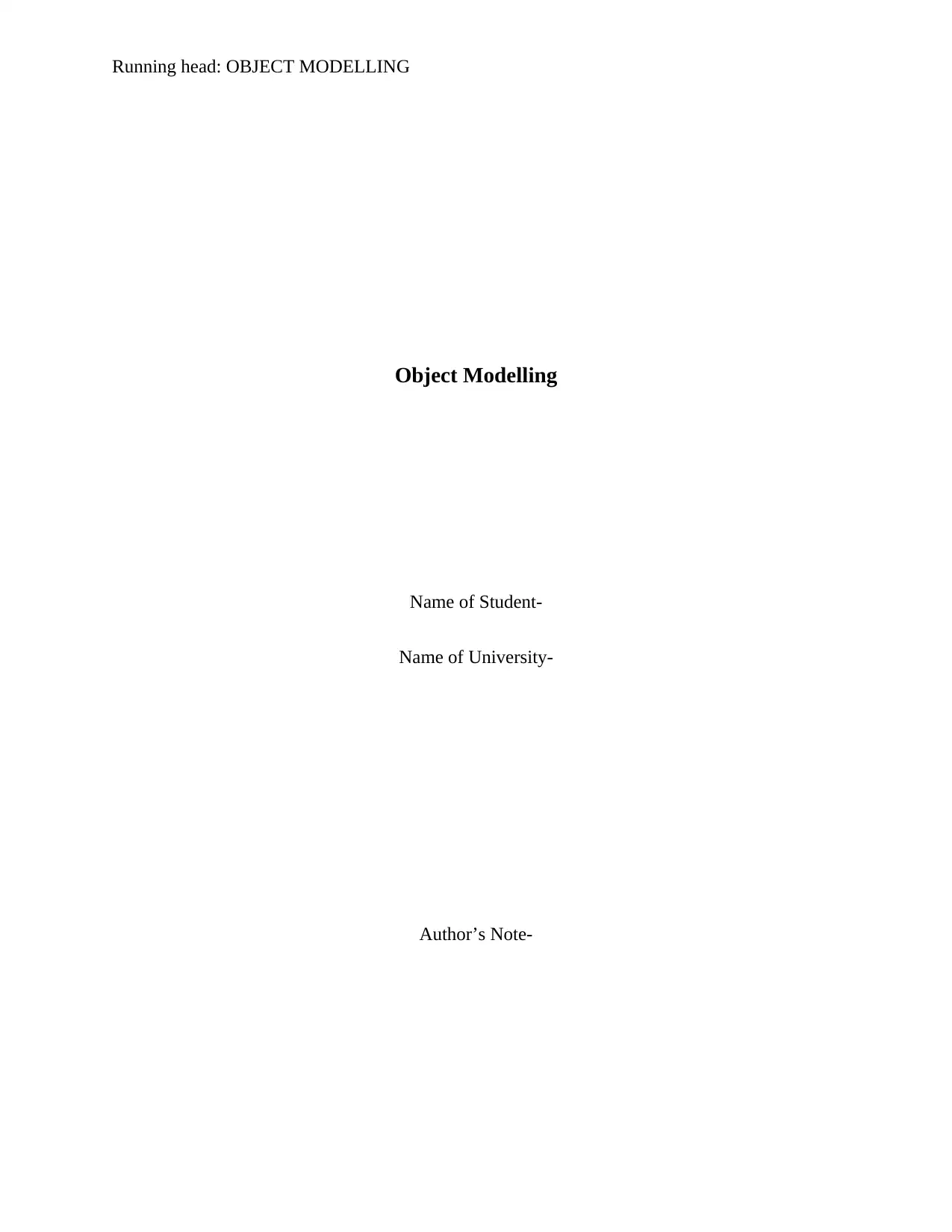
Running head: OBJECT MODELLING
Object Modelling
Name of Student-
Name of University-
Author’s Note-
Object Modelling
Name of Student-
Name of University-
Author’s Note-
Secure Best Marks with AI Grader
Need help grading? Try our AI Grader for instant feedback on your assignments.
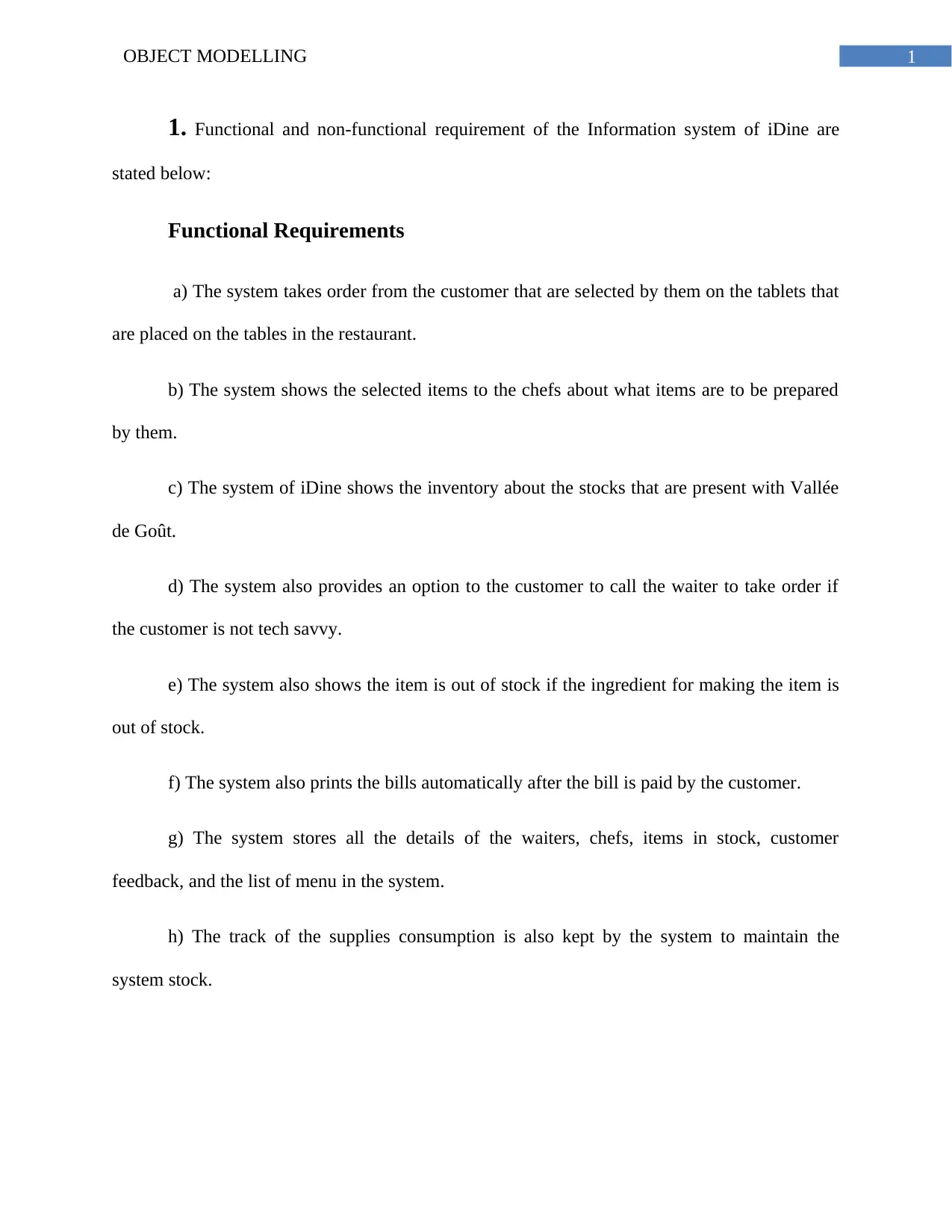
1OBJECT MODELLING
1. Functional and non-functional requirement of the Information system of iDine are
stated below:
Functional Requirements
a) The system takes order from the customer that are selected by them on the tablets that
are placed on the tables in the restaurant.
b) The system shows the selected items to the chefs about what items are to be prepared
by them.
c) The system of iDine shows the inventory about the stocks that are present with Vallée
de Goût.
d) The system also provides an option to the customer to call the waiter to take order if
the customer is not tech savvy.
e) The system also shows the item is out of stock if the ingredient for making the item is
out of stock.
f) The system also prints the bills automatically after the bill is paid by the customer.
g) The system stores all the details of the waiters, chefs, items in stock, customer
feedback, and the list of menu in the system.
h) The track of the supplies consumption is also kept by the system to maintain the
system stock.
1. Functional and non-functional requirement of the Information system of iDine are
stated below:
Functional Requirements
a) The system takes order from the customer that are selected by them on the tablets that
are placed on the tables in the restaurant.
b) The system shows the selected items to the chefs about what items are to be prepared
by them.
c) The system of iDine shows the inventory about the stocks that are present with Vallée
de Goût.
d) The system also provides an option to the customer to call the waiter to take order if
the customer is not tech savvy.
e) The system also shows the item is out of stock if the ingredient for making the item is
out of stock.
f) The system also prints the bills automatically after the bill is paid by the customer.
g) The system stores all the details of the waiters, chefs, items in stock, customer
feedback, and the list of menu in the system.
h) The track of the supplies consumption is also kept by the system to maintain the
system stock.

2OBJECT MODELLING
i) The food items that are most popular in the restaurant is also marked by the system by
which helps the chefs to get to know the unpopular items in the menu and change them
accordingly.
j) The system helps to compares the weekly sales with that of the food costs so that the
gain percentage can be studied.
k) The system also generates the sales diagram making it easier for the management to
understand the sales report.
Non-Functional Requirements
a) The system shares the items involved immediately when the customer selects the menu
on their tabletop tablets.
b) If an item is out of stock, then the system gives alert that the item is out of stock which
needs to be restocked again.
c) The system is secured by implementing the security features in the system.
d) iDine system also includes manageability that is capable of managing the data
securely.
e) Data integrity is maintained by iDine system where the details of the items and staffs
are securely stored in the system.
f) The system also maintains serviceability that provides the service when the customer
needs it.
i) The food items that are most popular in the restaurant is also marked by the system by
which helps the chefs to get to know the unpopular items in the menu and change them
accordingly.
j) The system helps to compares the weekly sales with that of the food costs so that the
gain percentage can be studied.
k) The system also generates the sales diagram making it easier for the management to
understand the sales report.
Non-Functional Requirements
a) The system shares the items involved immediately when the customer selects the menu
on their tabletop tablets.
b) If an item is out of stock, then the system gives alert that the item is out of stock which
needs to be restocked again.
c) The system is secured by implementing the security features in the system.
d) iDine system also includes manageability that is capable of managing the data
securely.
e) Data integrity is maintained by iDine system where the details of the items and staffs
are securely stored in the system.
f) The system also maintains serviceability that provides the service when the customer
needs it.
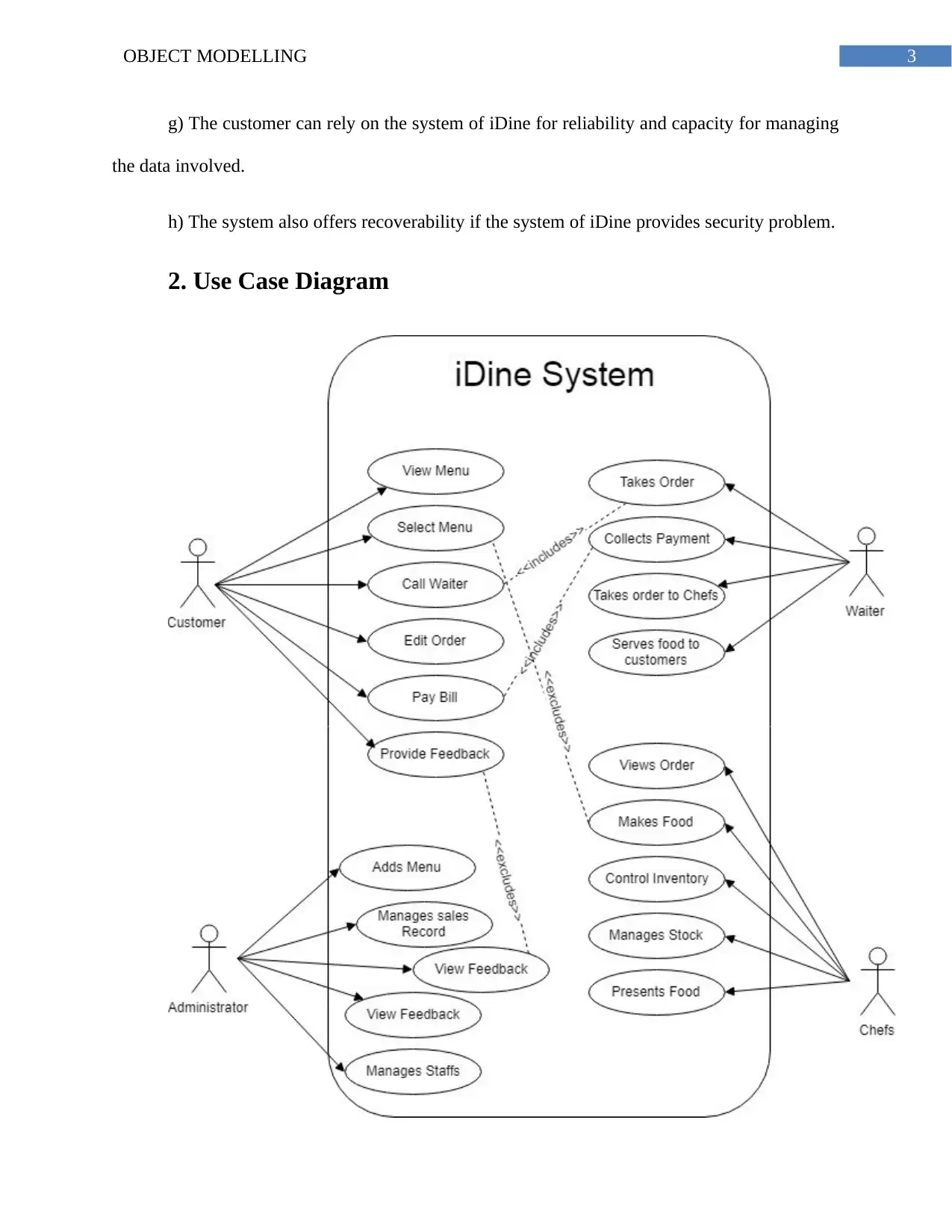
3OBJECT MODELLING
g) The customer can rely on the system of iDine for reliability and capacity for managing
the data involved.
h) The system also offers recoverability if the system of iDine provides security problem.
2. Use Case Diagram
g) The customer can rely on the system of iDine for reliability and capacity for managing
the data involved.
h) The system also offers recoverability if the system of iDine provides security problem.
2. Use Case Diagram
Secure Best Marks with AI Grader
Need help grading? Try our AI Grader for instant feedback on your assignments.
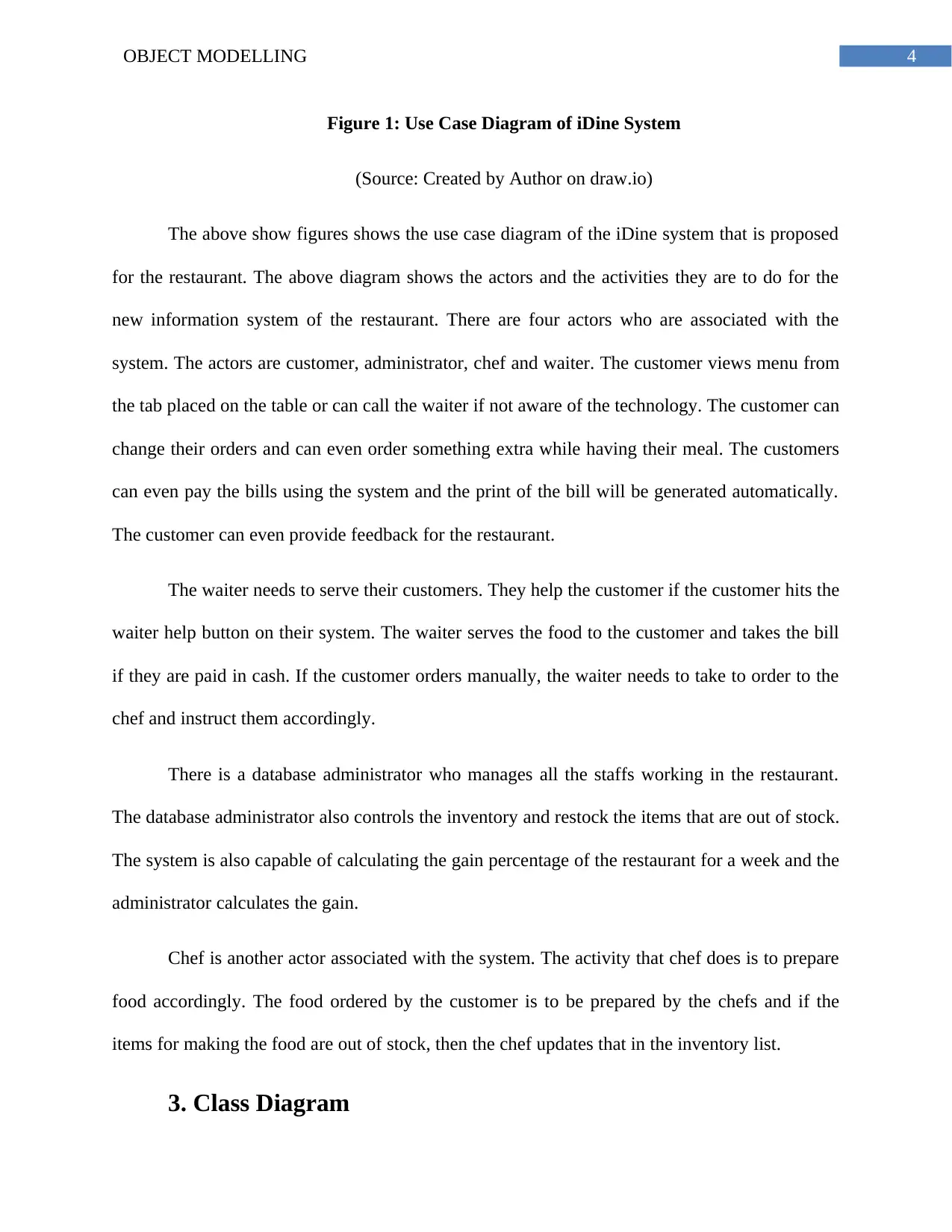
4OBJECT MODELLING
Figure 1: Use Case Diagram of iDine System
(Source: Created by Author on draw.io)
The above show figures shows the use case diagram of the iDine system that is proposed
for the restaurant. The above diagram shows the actors and the activities they are to do for the
new information system of the restaurant. There are four actors who are associated with the
system. The actors are customer, administrator, chef and waiter. The customer views menu from
the tab placed on the table or can call the waiter if not aware of the technology. The customer can
change their orders and can even order something extra while having their meal. The customers
can even pay the bills using the system and the print of the bill will be generated automatically.
The customer can even provide feedback for the restaurant.
The waiter needs to serve their customers. They help the customer if the customer hits the
waiter help button on their system. The waiter serves the food to the customer and takes the bill
if they are paid in cash. If the customer orders manually, the waiter needs to take to order to the
chef and instruct them accordingly.
There is a database administrator who manages all the staffs working in the restaurant.
The database administrator also controls the inventory and restock the items that are out of stock.
The system is also capable of calculating the gain percentage of the restaurant for a week and the
administrator calculates the gain.
Chef is another actor associated with the system. The activity that chef does is to prepare
food accordingly. The food ordered by the customer is to be prepared by the chefs and if the
items for making the food are out of stock, then the chef updates that in the inventory list.
3. Class Diagram
Figure 1: Use Case Diagram of iDine System
(Source: Created by Author on draw.io)
The above show figures shows the use case diagram of the iDine system that is proposed
for the restaurant. The above diagram shows the actors and the activities they are to do for the
new information system of the restaurant. There are four actors who are associated with the
system. The actors are customer, administrator, chef and waiter. The customer views menu from
the tab placed on the table or can call the waiter if not aware of the technology. The customer can
change their orders and can even order something extra while having their meal. The customers
can even pay the bills using the system and the print of the bill will be generated automatically.
The customer can even provide feedback for the restaurant.
The waiter needs to serve their customers. They help the customer if the customer hits the
waiter help button on their system. The waiter serves the food to the customer and takes the bill
if they are paid in cash. If the customer orders manually, the waiter needs to take to order to the
chef and instruct them accordingly.
There is a database administrator who manages all the staffs working in the restaurant.
The database administrator also controls the inventory and restock the items that are out of stock.
The system is also capable of calculating the gain percentage of the restaurant for a week and the
administrator calculates the gain.
Chef is another actor associated with the system. The activity that chef does is to prepare
food accordingly. The food ordered by the customer is to be prepared by the chefs and if the
items for making the food are out of stock, then the chef updates that in the inventory list.
3. Class Diagram
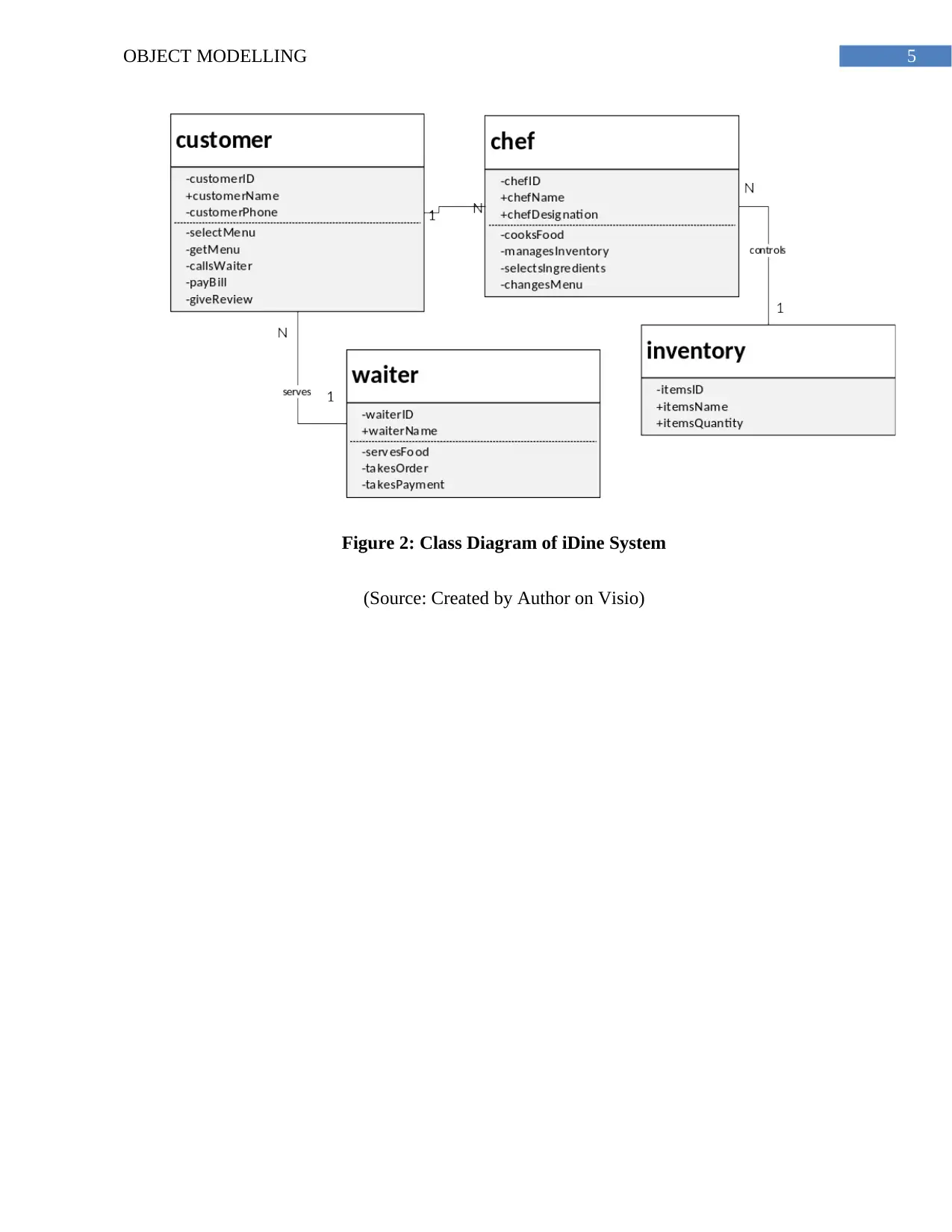
5OBJECT MODELLING
Figure 2: Class Diagram of iDine System
(Source: Created by Author on Visio)
Figure 2: Class Diagram of iDine System
(Source: Created by Author on Visio)
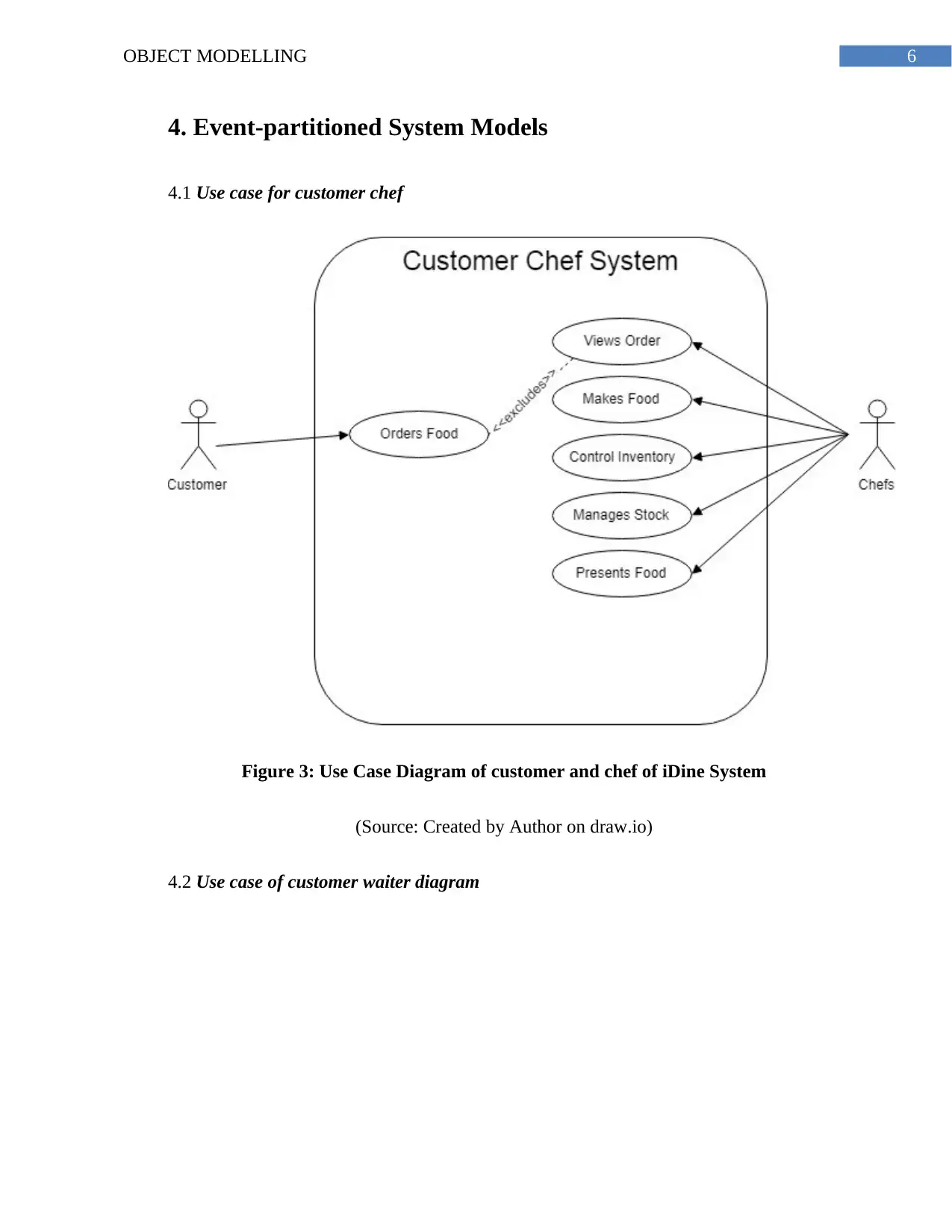
6OBJECT MODELLING
4. Event-partitioned System Models
4.1 Use case for customer chef
Figure 3: Use Case Diagram of customer and chef of iDine System
(Source: Created by Author on draw.io)
4.2 Use case of customer waiter diagram
4. Event-partitioned System Models
4.1 Use case for customer chef
Figure 3: Use Case Diagram of customer and chef of iDine System
(Source: Created by Author on draw.io)
4.2 Use case of customer waiter diagram
Paraphrase This Document
Need a fresh take? Get an instant paraphrase of this document with our AI Paraphraser
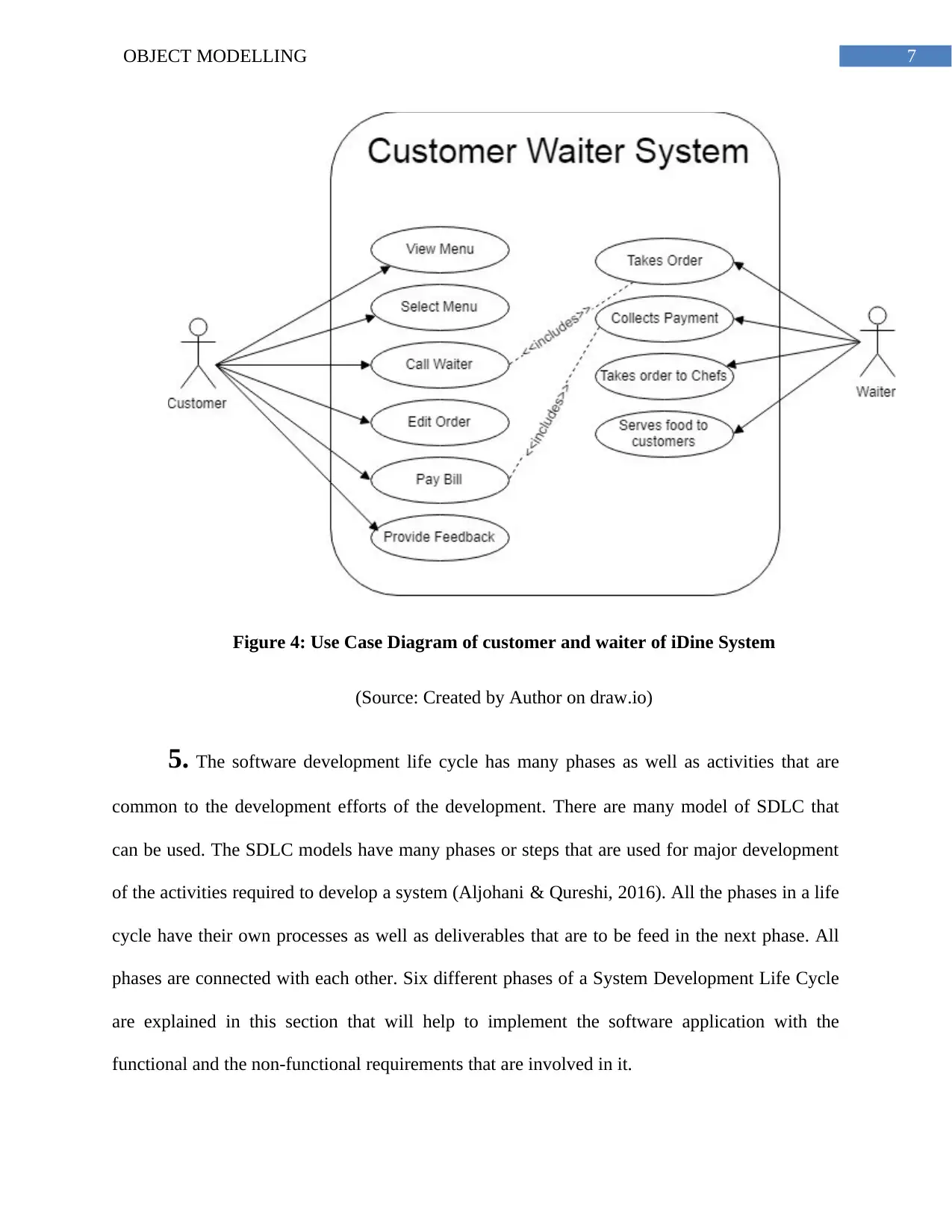
7OBJECT MODELLING
Figure 4: Use Case Diagram of customer and waiter of iDine System
(Source: Created by Author on draw.io)
5. The software development life cycle has many phases as well as activities that are
common to the development efforts of the development. There are many model of SDLC that
can be used. The SDLC models have many phases or steps that are used for major development
of the activities required to develop a system (Aljohani & Qureshi, 2016). All the phases in a life
cycle have their own processes as well as deliverables that are to be feed in the next phase. All
phases are connected with each other. Six different phases of a System Development Life Cycle
are explained in this section that will help to implement the software application with the
functional and the non-functional requirements that are involved in it.
Figure 4: Use Case Diagram of customer and waiter of iDine System
(Source: Created by Author on draw.io)
5. The software development life cycle has many phases as well as activities that are
common to the development efforts of the development. There are many model of SDLC that
can be used. The SDLC models have many phases or steps that are used for major development
of the activities required to develop a system (Aljohani & Qureshi, 2016). All the phases in a life
cycle have their own processes as well as deliverables that are to be feed in the next phase. All
phases are connected with each other. Six different phases of a System Development Life Cycle
are explained in this section that will help to implement the software application with the
functional and the non-functional requirements that are involved in it.
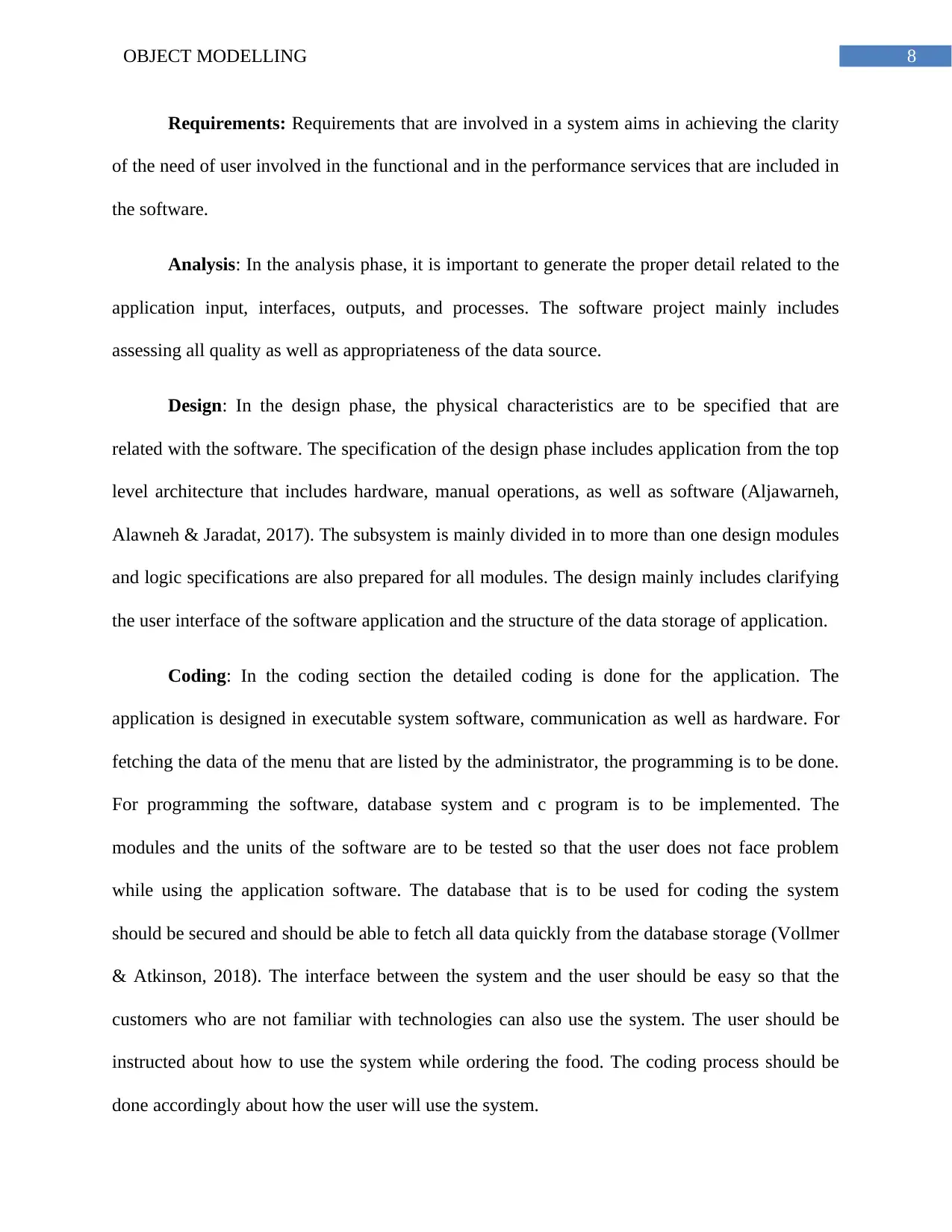
8OBJECT MODELLING
Requirements: Requirements that are involved in a system aims in achieving the clarity
of the need of user involved in the functional and in the performance services that are included in
the software.
Analysis: In the analysis phase, it is important to generate the proper detail related to the
application input, interfaces, outputs, and processes. The software project mainly includes
assessing all quality as well as appropriateness of the data source.
Design: In the design phase, the physical characteristics are to be specified that are
related with the software. The specification of the design phase includes application from the top
level architecture that includes hardware, manual operations, as well as software (Aljawarneh,
Alawneh & Jaradat, 2017). The subsystem is mainly divided in to more than one design modules
and logic specifications are also prepared for all modules. The design mainly includes clarifying
the user interface of the software application and the structure of the data storage of application.
Coding: In the coding section the detailed coding is done for the application. The
application is designed in executable system software, communication as well as hardware. For
fetching the data of the menu that are listed by the administrator, the programming is to be done.
For programming the software, database system and c program is to be implemented. The
modules and the units of the software are to be tested so that the user does not face problem
while using the application software. The database that is to be used for coding the system
should be secured and should be able to fetch all data quickly from the database storage (Vollmer
& Atkinson, 2018). The interface between the system and the user should be easy so that the
customers who are not familiar with technologies can also use the system. The user should be
instructed about how to use the system while ordering the food. The coding process should be
done accordingly about how the user will use the system.
Requirements: Requirements that are involved in a system aims in achieving the clarity
of the need of user involved in the functional and in the performance services that are included in
the software.
Analysis: In the analysis phase, it is important to generate the proper detail related to the
application input, interfaces, outputs, and processes. The software project mainly includes
assessing all quality as well as appropriateness of the data source.
Design: In the design phase, the physical characteristics are to be specified that are
related with the software. The specification of the design phase includes application from the top
level architecture that includes hardware, manual operations, as well as software (Aljawarneh,
Alawneh & Jaradat, 2017). The subsystem is mainly divided in to more than one design modules
and logic specifications are also prepared for all modules. The design mainly includes clarifying
the user interface of the software application and the structure of the data storage of application.
Coding: In the coding section the detailed coding is done for the application. The
application is designed in executable system software, communication as well as hardware. For
fetching the data of the menu that are listed by the administrator, the programming is to be done.
For programming the software, database system and c program is to be implemented. The
modules and the units of the software are to be tested so that the user does not face problem
while using the application software. The database that is to be used for coding the system
should be secured and should be able to fetch all data quickly from the database storage (Vollmer
& Atkinson, 2018). The interface between the system and the user should be easy so that the
customers who are not familiar with technologies can also use the system. The user should be
instructed about how to use the system while ordering the food. The coding process should be
done accordingly about how the user will use the system.
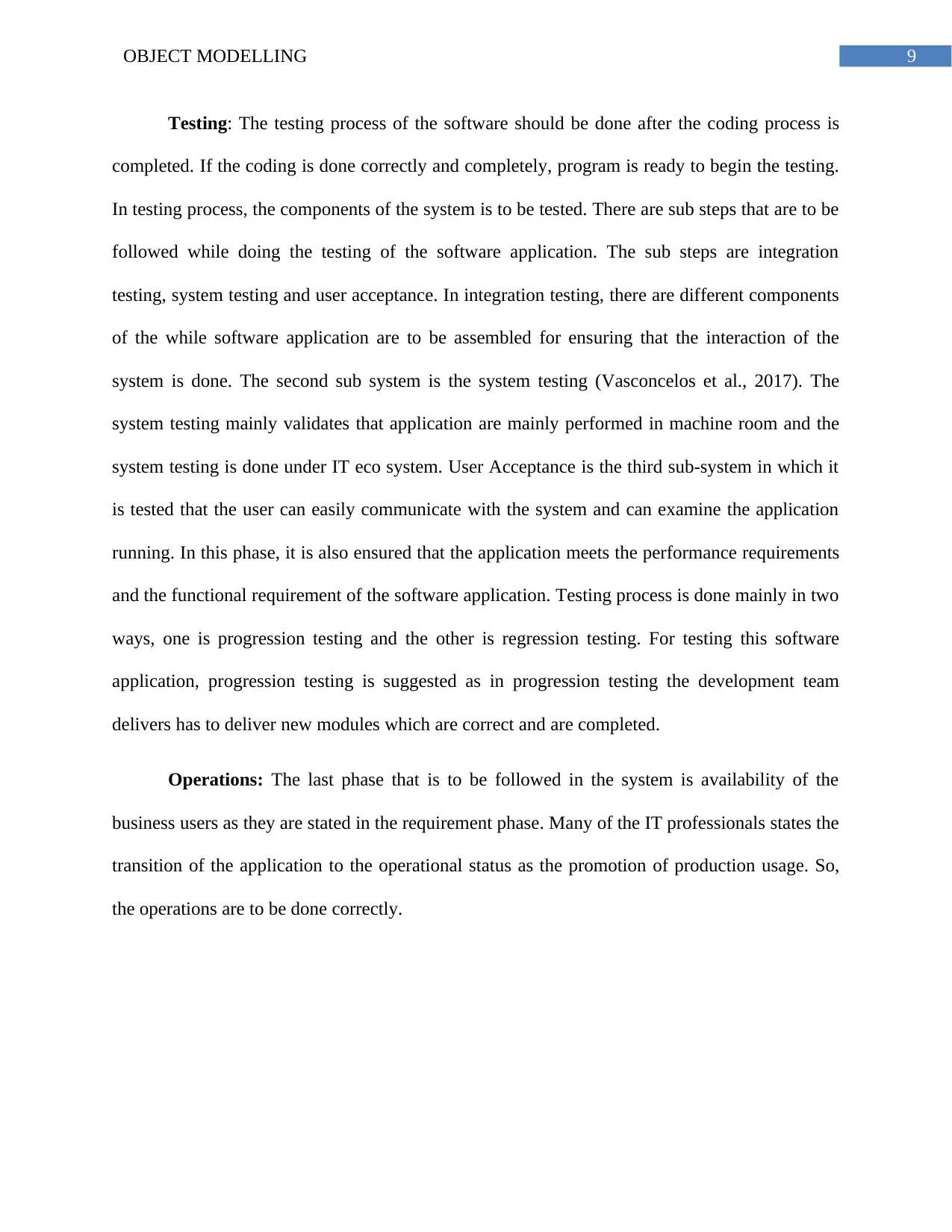
9OBJECT MODELLING
Testing: The testing process of the software should be done after the coding process is
completed. If the coding is done correctly and completely, program is ready to begin the testing.
In testing process, the components of the system is to be tested. There are sub steps that are to be
followed while doing the testing of the software application. The sub steps are integration
testing, system testing and user acceptance. In integration testing, there are different components
of the while software application are to be assembled for ensuring that the interaction of the
system is done. The second sub system is the system testing (Vasconcelos et al., 2017). The
system testing mainly validates that application are mainly performed in machine room and the
system testing is done under IT eco system. User Acceptance is the third sub-system in which it
is tested that the user can easily communicate with the system and can examine the application
running. In this phase, it is also ensured that the application meets the performance requirements
and the functional requirement of the software application. Testing process is done mainly in two
ways, one is progression testing and the other is regression testing. For testing this software
application, progression testing is suggested as in progression testing the development team
delivers has to deliver new modules which are correct and are completed.
Operations: The last phase that is to be followed in the system is availability of the
business users as they are stated in the requirement phase. Many of the IT professionals states the
transition of the application to the operational status as the promotion of production usage. So,
the operations are to be done correctly.
Testing: The testing process of the software should be done after the coding process is
completed. If the coding is done correctly and completely, program is ready to begin the testing.
In testing process, the components of the system is to be tested. There are sub steps that are to be
followed while doing the testing of the software application. The sub steps are integration
testing, system testing and user acceptance. In integration testing, there are different components
of the while software application are to be assembled for ensuring that the interaction of the
system is done. The second sub system is the system testing (Vasconcelos et al., 2017). The
system testing mainly validates that application are mainly performed in machine room and the
system testing is done under IT eco system. User Acceptance is the third sub-system in which it
is tested that the user can easily communicate with the system and can examine the application
running. In this phase, it is also ensured that the application meets the performance requirements
and the functional requirement of the software application. Testing process is done mainly in two
ways, one is progression testing and the other is regression testing. For testing this software
application, progression testing is suggested as in progression testing the development team
delivers has to deliver new modules which are correct and are completed.
Operations: The last phase that is to be followed in the system is availability of the
business users as they are stated in the requirement phase. Many of the IT professionals states the
transition of the application to the operational status as the promotion of production usage. So,
the operations are to be done correctly.
Secure Best Marks with AI Grader
Need help grading? Try our AI Grader for instant feedback on your assignments.
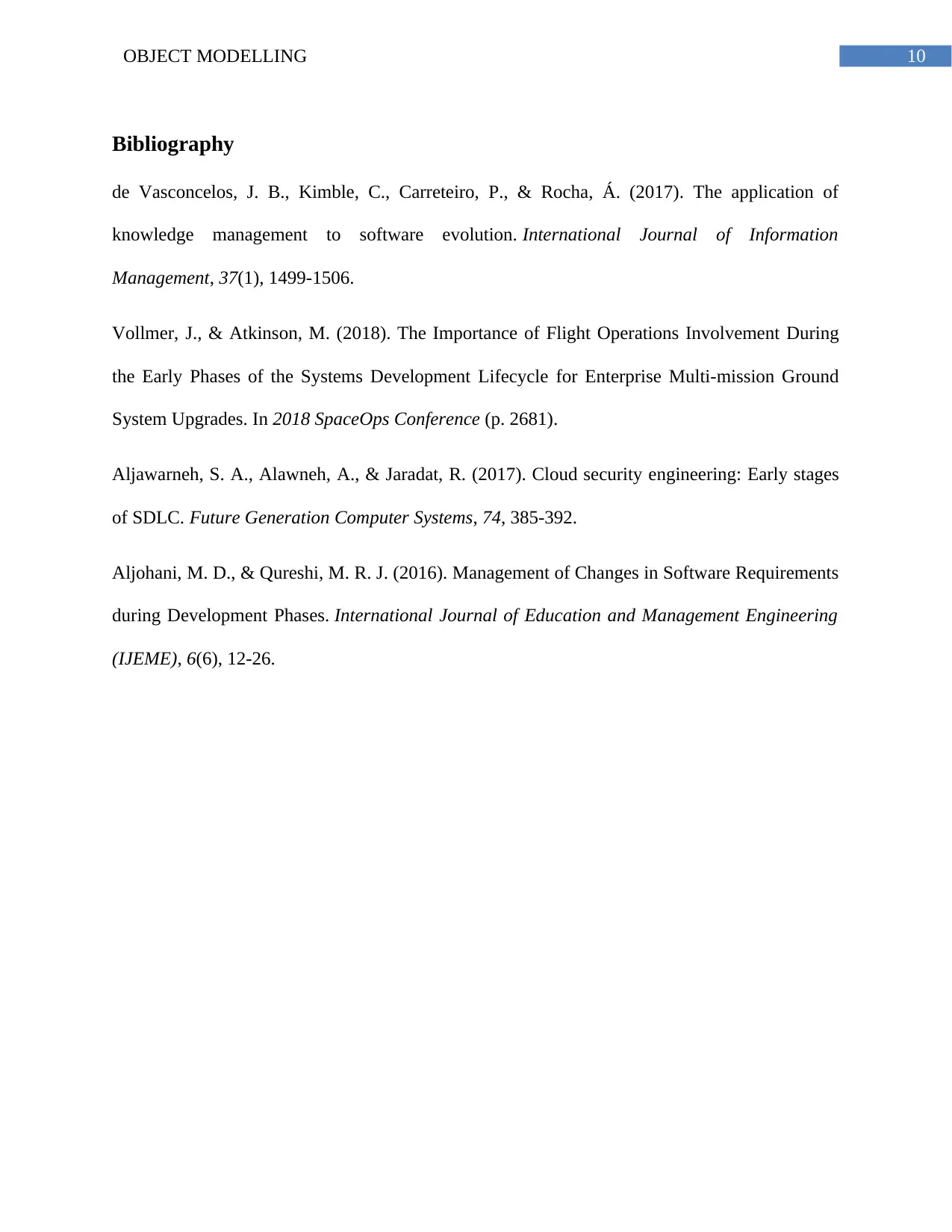
10OBJECT MODELLING
Bibliography
de Vasconcelos, J. B., Kimble, C., Carreteiro, P., & Rocha, Á. (2017). The application of
knowledge management to software evolution. International Journal of Information
Management, 37(1), 1499-1506.
Vollmer, J., & Atkinson, M. (2018). The Importance of Flight Operations Involvement During
the Early Phases of the Systems Development Lifecycle for Enterprise Multi-mission Ground
System Upgrades. In 2018 SpaceOps Conference (p. 2681).
Aljawarneh, S. A., Alawneh, A., & Jaradat, R. (2017). Cloud security engineering: Early stages
of SDLC. Future Generation Computer Systems, 74, 385-392.
Aljohani, M. D., & Qureshi, M. R. J. (2016). Management of Changes in Software Requirements
during Development Phases. International Journal of Education and Management Engineering
(IJEME), 6(6), 12-26.
Bibliography
de Vasconcelos, J. B., Kimble, C., Carreteiro, P., & Rocha, Á. (2017). The application of
knowledge management to software evolution. International Journal of Information
Management, 37(1), 1499-1506.
Vollmer, J., & Atkinson, M. (2018). The Importance of Flight Operations Involvement During
the Early Phases of the Systems Development Lifecycle for Enterprise Multi-mission Ground
System Upgrades. In 2018 SpaceOps Conference (p. 2681).
Aljawarneh, S. A., Alawneh, A., & Jaradat, R. (2017). Cloud security engineering: Early stages
of SDLC. Future Generation Computer Systems, 74, 385-392.
Aljohani, M. D., & Qureshi, M. R. J. (2016). Management of Changes in Software Requirements
during Development Phases. International Journal of Education and Management Engineering
(IJEME), 6(6), 12-26.
1 out of 11
Related Documents
Your All-in-One AI-Powered Toolkit for Academic Success.
+13062052269
info@desklib.com
Available 24*7 on WhatsApp / Email
![[object Object]](/_next/static/media/star-bottom.7253800d.svg)
Unlock your academic potential
© 2024 | Zucol Services PVT LTD | All rights reserved.





